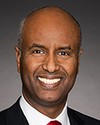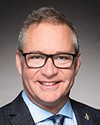Madam Speaker, as I stated, several witnesses to this study identified several critical barriers to indigenous economic independence and development. We are talking about the issues of limited access to capital, inadequate infrastructure and, in some cases, lack of capacity. Of course, we go on to say that many indigenous communities are already working on their own solutions to these issues and they require further supports from the Government of Canada.
Indigenous peoples have long been excluded from key decision-making processes, which has hindered their ability to fully participate in economic development. Clarence T. Jules, otherwise known as Manny Jules to many, chief commissioner of the First Nations Tax Commission, pointed out that indigenous peoples have lost control over their fiscal powers and lands as a result of these historical exclusions. Infrastructure is essential for driving indigenous economic development, serving as a backbone of a functional economy.
Before I continue on with the reports, I would like to remind people that I am splitting my time with the hon. member for Sherwood Park—Fort Saskatchewan.
Experts such as Clint Davis from Nunasi Corporation and Ernie Daniels of the First Nations Finance Authority have underscored the importance of closing the significant infrastructure gap, estimated at about $30 billion, between first nations and other Canadian communities. The Nunavut infrastructure gap report, for example, highlights critical shortages in water, housing, broadband and energy systems. The overall infrastructure gap for indigenous communities there could be as high as $70 billion.
Housing, of course, is another urgent issue. Shannin Metatawabin from the National Aboriginal Capital Corporations Association has proposed the creation of an indigenous housing fund in partnership with aboriginal financial institutions. This fund would help secure financing for housing in indigenous communities.
Similarly, Grand Chief Jerry Daniels of the Southern Chiefs' Organization Inc. recommended offering long-term loan guarantees to support capital projects, including housing initiatives. To help bridge the infrastructure gap, Daniels has suggested exploring monetization as a funding approach. This method, commonly used by municipalities to finance projects, involves issuing debentures to raise capital for infrastructure and economic development. Daniels also proposed a pilot project to replace diesel generation in remote communities potentially funded through this model. This approach could not only reduce dependence on federal funding, but also provide a sustainable, clean energy solution while testing innovative financing strategies at a minimal cost to the government.
The committee was informed that administrative obstacles pose significant challenges to indigenous economic development, especially when it comes to accessing public funding. Witnesses highlighted issues such as time-consuming and repetitive processes of submitting applications, as well as confusion around program eligibility requirements. To address these challenges, Harold Calla from the First Nations Financial Management Board proposed a pilot project aimed at streamlining administrative functions for smaller communities. Some of those smaller communities can lack the resources to manage such tasks efficiently.
Furthermore, Tabatha Bull from the Canadian Council for Aboriginal Business recommended the creation of a navigator position to assist indigenous businesses in navigating government programs and grant applications. This role would help entrepreneurs identify relevant funding opportunities and support a need that has been frequently emphasized by indigenous business owners.
Witnesses also emphasized that the current funding for indigenous economic development is inadequate and often lacks the structure needed to foster long-term growth. Regional Chief Teegee called for a shift away from short-term program funding, advocating for more substantial and predictable financial support, particularly for areas like first nations policing. He stressed that this approach would also be extended to economic development initiatives.
Access to capital and equity was identified as another key barrier to indigenous economic progress.
Grand Chief Daniels of the Southern Chiefs' Organization highlighted that, without equity, indigenous communities face significant challenges in launching and sustaining wealth-building ventures. Securing capital, particularly for large-scale projects in sectors like energy, mining and agriculture, remains difficult due to historical disadvantages and bureaucratic obstacles. Chief Commissioner Manny Jules pointed out that indigenous peoples face a $175-billion gap in access to capital. Several leaders also underscored the mutual benefits of improving access to capital.
Mr. Metatawabin announced that indigenous communities represent profitable investment opportunities. Although progress has been made, such as through impact benefit agreements, communities still encounter financial barriers that prevent full participation in major projects. Traditional lenders are unwilling to finance equity, leaving communities either unstable or unable to secure necessary funds or forced to accept costly, unfavourable terms.
Several witnesses emphasized the need to increase indigenous participation in public procurement and highlighted the ongoing barriers to achieving this very goal. In April 2022, the Minister of Indigenous Services announced that 32 federal departments would be required to allocate at least 5% of federal contracts to indigenous-owned, indigenous-led businesses.
However, since then, the program has faced significant shortcomings. There have been reports of companies and individuals exploiting the procurement strategy for indigenous businesses, falsely claiming indigenous status in order to secure contracts. Some have even gone so far as to submit fraudulent documents, such as a picture of a rabbit, to qualify for the program.
A particularly troubling issue involves the employment minister's past business dealings, specifically his connection to Global Health Imports. The company, co-owned by the employment minister, falsely represented itself as a wholly indigenous-owned business in order to obtain government contracts through Canada's indigenous procurement programs, programs designed to benefit indigenous communities. Such misrepresentation undermines the very purpose of the programs, which are intended to support indigenous peoples and businesses.
I could go on, but I will just wrap up by saying that there are many examples of indigenous entrepreneurship and initiative. Conservatives are inspired by their vision and their drive. A future Conservative government will partner with indigenous communities to realize their aspirations, and we will be laser-focused in fostering economic growth and creating opportunities for indigenous communities.











